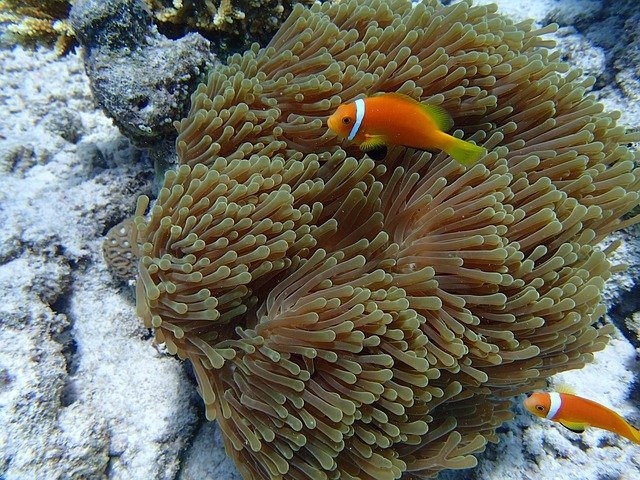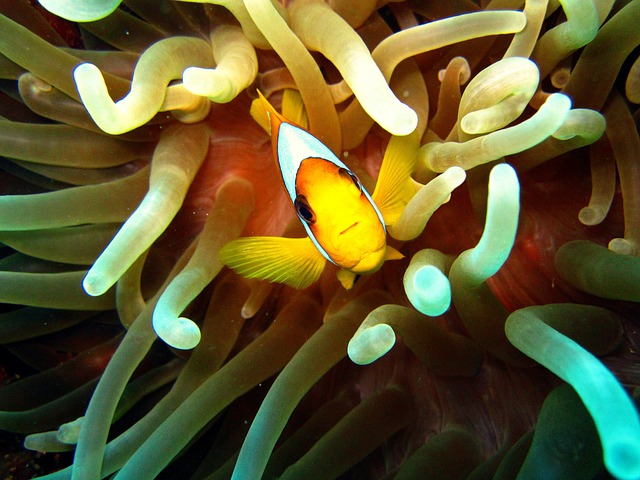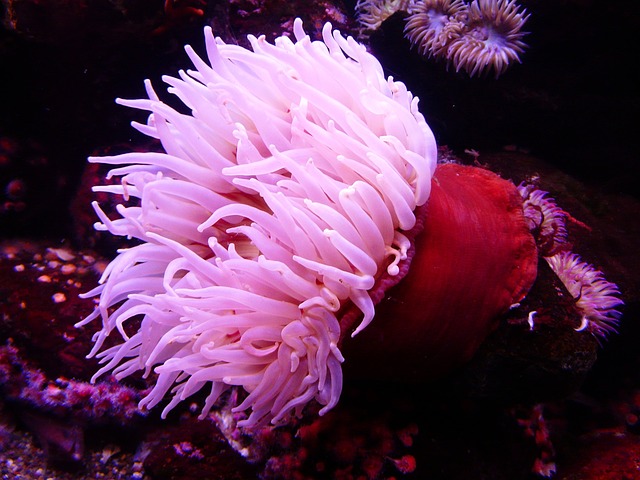
Sea Anemone
Classified under the genus Actinia
A sea anemone is a marine invertebrate that belongs to the phylum Cnidaria, which also includes jellyfish and corals. They are named after the anemone flower because of their colorful and flower-like appearance. Sea anemones are predatory animals, often attaching themselves to rocks, coral, or other hard surfaces in shallow coastal waters.
Many individual species of sea anemones have not yet been evaluated by the IUCN.
Sea anemones are fascinating marine invertebrates that resemble vibrant, underwater flowers, belonging to the phylum Cnidaria. Found in oceans worldwide, they are predatory animals with a cylindrical body topped by a crown of stinging tentacles, which they use to capture prey like fish and plankton.
These tentacles contain specialized cells called nematocysts that inject venom into prey, paralyzing it before it is drawn into their central mouth for digestion. Despite their stationary appearance, sea anemones can slowly move by gliding on their base or detaching and drifting to new locations.
Many species engage in symbiotic relationships with other marine organisms, such as clownfish, which live within their tentacles for protection. Sea anemones come in a stunning array of colors, contributing to the rich biodiversity of coral reefs and rocky shores.

Navite Location
Sea anemones are found in oceans all around the world.
Varieties
Bubble Tip / Beadlet / Giant Green / Carpet / Sebae / Tube
Suggested Tank Mates
Clownfish / Gobies / Shrimp / Damselfish / Cardinalfish
Tank Mates to Avoid
Triggerfish / Pufferfish / Lionfish / Butterflyfish
Diet
Small fish / Crustaceans / Zooplankton / Frozen Foods / Direct Feeding
Breeding
Release of sperm and eggs into the water, free-swimming larvae
Lifespan
With excellent care, some species can live for decades
Size
30 – 60cm (11.8 – 23.6in) depending on species
Minimum Tank Size
75 – 284 Liters (20-75 gallons) depending on species
Optimum Tank Temperature (depending on species)
Tropical Sea Anemones: 75°F to 80°F (24°C to 27°C)
Cold-Water Sea Anemones: 50°F to 60°F (10°C to 15°C)
Ideal pH Level
8.1 to 8.4
Ideal Carbonate Hardness
8 – 12 dKH
Common Health Issues
Bleaching / Shrinking or Shriveling / Infections / Mouth Gaping or Eversion / Lack of Feeding Response / Dislodgement / Tentacle Loss or Damage / Light-Related Issues / Chemical Sensitivity
Interesting facts
Close Relatives to Jellyfish and Corals
Sea anemones are part of the phylum Cnidaria, which means they are closely related to jellyfish and corals. They all share the characteristic of having stinging cells (nematocysts) for capturing prey.
Some Can Live for Over a Century
Sea anemones have a remarkable potential for longevity. Some species can live for 50 years or more, and certain individuals may live well over 100 years if they are not eaten or killed by other environmental factors.
Symbiotic Relationships with Clownfish
The famous relationship between sea anemones and clownfish (like Amphiprion ocellaris) is a fascinating example of symbiosis. Clownfish live within the tentacles of sea anemones for protection, while the clownfish helps to clean the anemone and even provide food scraps.
Stinging Tentacles
Sea anemones capture their prey using specialized stinging cells called nematocysts, which inject venom into small fish, plankton, or invertebrates. Once stung and paralyzed, the prey is brought into the anemone’s mouth for digestion.
Asexual Reproduction
In addition to reproducing sexually, many sea anemones can reproduce asexually through processes like binary fission, where they split into two genetically identical individuals, or pedal laceration, where small pieces of their base break off and grow into new anemones.
Can Move, But Slowly
While sea anemones are often seen attached to rocks or coral, they can move—albeit very slowly. They use their “foot” or pedal disc to glide along surfaces or, in some cases, detach and drift to a new location if the environment becomes unsuitable.



Sea Anemone FAQ’s
Are Sea Anemones Biotic?
Yes, sea anemones are biotic.
“Biotic” refers to living organisms, and sea anemones are living creatures that interact with other organisms in their ecosystem, such as fish, algae, and other marine life. They are part of the biotic components of their environments, contributing to the balance of marine ecosystems.
Are Sea Anemones Cold Blooded?
Yes, sea anemones are cold-blooded (ectothermic) animals. This means their body temperature is regulated by the surrounding environment, and they do not generate their own heat like warm-blooded animals do. Their metabolic processes depend on the temperature of the water they live in, which is why maintaining stable water conditions is important for their health.
Are Sea Anemones Dangerous to Humans?
Most sea anemones are not dangerous to humans. Their stinging cells (nematocysts) are used to capture prey but are generally too weak to penetrate human skin.
However, some larger species can cause mild irritation, itching, or a rash if touched. It’s best to handle them with care or avoid touching them altogether to prevent any discomfort.
Are Sea Anemones Hard to Care For
Sea anemones can be challenging to care for, especially for beginners. They require stable water conditions, strong lighting, proper water flow, and consistent feeding.
Some species are hardier than others, but overall, anemones are sensitive to changes in their environment and need specific care to thrive in captivity.
Can Sea Anemones Change Color?
Yes, sea anemones can change color, but this is often a response to environmental factors such as lighting, stress, or changes in water conditions.
Color changes can also occur if the anemone expels or loses its symbiotic algae (zooxanthellae) during a process called bleaching, which can make it appear paler or white. Additionally, some anemones naturally have color variations due to genetic factors or pigmentation changes.
Can Sea Anemones Get Ich?
No, sea anemones cannot get ich (Ichthyophthirius multifiliis), a parasitic disease that primarily affects fish.
Ich is a protozoan parasite that specifically targets fish gills and skin, and sea anemones, being invertebrates, are not susceptible to this parasite.
However, fish living in the same tank as sea anemones can still get ich, so it’s important to monitor overall tank health and treat the fish separately if necessary.
Can Sea Anemones Kill Fish?
Yes, sea anemones can kill fish by using their stinging tentacles to capture and immobilize them.
The tentacles contain nematocysts, which release venom to paralyze small fish and other prey. However, fish like clownfish have a symbiotic relationship with certain anemones and are immune to their stings. Fish that are not adapted to this relationship can be stung and potentially killed if they come into contact with the anemone’s tentacles.
Can Sea Anemones Molt?
No, sea anemones do not molt.
Molting is a process typically seen in animals with exoskeletons, such as crustaceans and insects, where they shed their outer shell to grow. Sea anemones, being soft-bodied invertebrates, do not have an exoskeleton or any similar structure to shed. Instead, they grow by expanding their soft tissues and regenerating damaged parts.
Do Sea Anemones Need Light?
Yes, many sea anemones need light, particularly those that host symbiotic algae called zooxanthellae in their tissues. These algae photosynthesize and provide nutrients to the anemone, which requires strong light, similar to the conditions found in coral reefs. However, some species that live in deeper or darker waters do not rely on light as much and obtain nutrients solely from catching prey.
For most common aquarium species, proper lighting is essential.
Do Sea Anemones Poop?
Yes, sea anemones do poop. They have a single opening that functions as both their mouth and their anus, so after digesting food, they expel waste through the same opening. This process is part of their simple digestive system.
How Fast Can a Sea Anemone Travel?
Sea anemones move very slowly, typically by gliding on their foot (called a pedal disc). They can move at a pace of just a few millimeters per hour, though they often remain stationary for long periods.
Some species may detach and drift with currents, but active movement is usually very slow.
How Fast Do Sea Anemones Grow?
Sea anemones grow relatively slowly, and their growth rate depends on several factors such as species, environmental conditions, availability of food, water quality, and light. In ideal conditions, they may grow a few millimeters to a centimeter per year. However, their growth can vary significantly, and in captivity, factors like regular feeding and stable water conditions can promote faster growth. Some species may take several years to reach their full size.
How Long Can a Sea Anemone Live Out of Water?
Sea anemones can survive out of water for short periods, typically a few hours, as long as they remain moist.
However, they are highly sensitive to drying out and require water to breathe and function properly. Prolonged exposure to air will cause stress, dehydration, and eventually death. It’s important to minimize their time out of water.
Why are Sea Anemones Sticky?
Sea anemones feel sticky to the touch because of their tentacles, which are covered in stinging cells called nematocysts. These cells release tiny harpoons to capture prey, causing the sticky sensation. However, most humans won’t feel a sting, just a mild stickiness.
Will an Anemone Eat a Clownfish?
No, sea anemones will not eat clownfish. Clownfish have a special symbiotic relationship with certain species of sea anemones and are immune to their stinging cells due to a protective mucus on their skin. Instead of being prey, clownfish live among the anemone’s tentacles for protection from predators.
